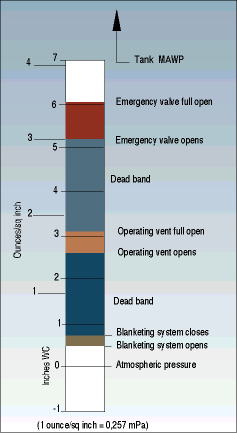
Over many years, gas blanketing has become a widely accepted practice in many industries. The process of gas blanketing is simply to create and maintain a slightly positive pressure in a storage tank, vessel or container with an inert gas.
Gas blankets are normally applied to closed vessels to prevent one or more of the following scenarios from occurring:
* Prevent vapourisation of the liquid being blanketed.
* Reduce fluid ignition potential.
* Prevent ingress of atmospheric air.
* Prevent vacuum formation.
* Reduce moisture content.
* Prevent oxidisation.
Gas blanketing can be conducted by use of control valves, however, due to their speed of response and sensitivity, regulators are widely used throughout the industry to fulfil this function. The two prime facets of the gas blanketing process are the gas blanketing regulator and the vapour recovery regulator.
Gas blanketing regulator
The gas blanketing regulator's function is to replace the void that would be left in the vessel during 'pump out' or thermal cooling, of the stored fluid whilst accurately maintaining the desired blanketing pressure. Whereas self-operated regulators will perform the function of gas blanketing in many cases, it is often found that high volume, pilot-operated regulators are required to satisfy the required flow rate and maintain accurate blanketing pressure.
Vapour recovery regulators
The function of these units is the inverse of the gas-blanketing regulator and releases the excess pressure generated by either 'pump in' or thermal expansion, of the stored fluid. As with the gas blanketing regulators, either self-operated or high volume, pilot-operated units are used dependent on required flow rate.
Should the vapour recovery system fail to limit the rise in pressure in the vessel then emergency tank vents are set to open at prescribed pressures.
Deadband and pressure settings
It is important that sufficient deadband is set up between the point at which the blanketing valve closes and the vapour recovery valve starts opening (see Figure 1). Failure to do this could result in both units passing fluid at the same time, which could result in blanketing product loss. Likewise, there must be a dead band between the maximum pressure at which the vapour recovery valve controls and the opening pressure of the emergency vent valve (see Figure 1).
Storage vessels are prone to leakage of blanketing fluid through ill-fitting flaps of emergency tank vents etc. Such leakage can be expensive to overall plant operation. Lower blanketing pressures allow the potential leakage rates to be reduced considerably and hence provide the user with significant 'bottom line' savings.

To enable lower blanketing pressure to be achieved we need to consider installation of high quality gas blanketing equipment which has the ability to provide us with a minimal amount of offset from setpoint. High quality gas blanketing systems supplied by Appalachian Controls Environmental (ACE), part of Fisher Controls International, have unique features that allow such control to be achieved. Such features include:
* Largest diaphragms - high levels of sensitivity.
* Rolling diaphragm - balanced system.
* Diagnostics.
Diagnostics
This unique feature, claimed to only be available from ACE, provides the maintenance engineer with a visual overview of the functionality of the unit. Indications on the locally mounted gauge will show -
* Inlet pressure to the unit.
* Pressure at which the pilot valve starts to open.
* Pressure at which the main valve starts to open.
* Pressure at which the main valve is fully open.
This indication may also be run to a remote location. By use of a P/I an electronic signal may be transmitted to a control room to indicate the current operational status of the unit - is it flowing etc.
Combined blanketing and vapour recovery units
The function of blanketing and vapour recovery is available to the industry from ACE. The advantage of such a unit is that the vessel supplier needs to only supply one connection point on the vessel to satisfy both functions.
It can be seen that careful consideration must be given to the correct selection of gas blanketing and vapour recovery equipment. Correct selection of quality devices will bring long-term benefits to the plant operator both in reduction in maintenance and also increased operating profits.
ACE gas blanketing regulators compliment the existing range of gas regulators that Fisher Rosemount offers to the industry. Local engineering support is available through their local representatives to assist engineers in selecting the best equipment to suit their application.
Alpret Control Specialists
(011) 249 6700
© Technews Publishing (Pty) Ltd | All Rights Reserved